当前位置:网站首页>UCORE lab2 physical memory management experiment report
UCORE lab2 physical memory management experiment report
2022-07-06 15:06:00 【Wuhu hanjinlun】
After experiment 1, we made a system that can be started , Experiment 2 mainly involves the physical memory management of the operating system . The operating system in order to use memory , You also need to efficiently manage memory resources . In Experiment 2, you will understand and complete a simple physical memory management system by yourself .、
The experiment purpose
- Understand the translation mechanism based on segment page memory address
- Understand the establishment and use of page table
- Understand how to manage physical memory
Experimental content
This experiment consists of three parts . First, learn how to discover the physical memory in the system ; Then learn how to establish a preliminary management of physical memory , That is, understanding continuous physical memory management ; Finally, understand the operation related to page table , That is, how to establish a page table to realize the mapping between virtual memory and physical memory , Have a comprehensive understanding of segment page memory management mechanism . The memory management implemented in this experiment is still very basic , It doesn't involve the optimization of the actual machine , For example cache Optimization, etc . If you have spare time , Try to complete the extension exercise .
practice
practice 0: Fill in the existing experiment
This experiment relies on experiments 1. Please take your experiment 1 Fill in the code in this experiment. There are “LAB1” The corresponding part of the notes . Tips : May adopt diff and patch Tool for semi-automatic merging (merge), Some graphical comparisons can also be used /merge Tools to manually merge , such as meld,eclipse Medium diff/merge Tools ,understand Medium diff/merge Tools etc. .
Pictured , open meld Software 
And then lab1 and lab2 Compare the contents of 
The result of the comparison is 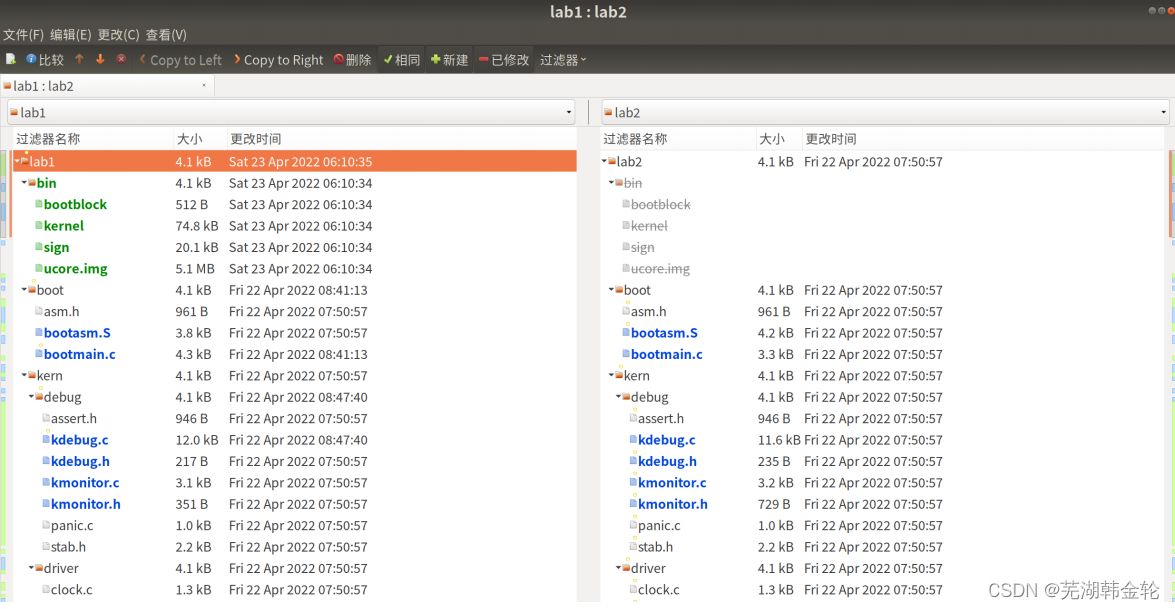
Among them * Document marked with , That is, different files , Copy it
To lab2 that will do . The final will be kern/debug/kdebug.ckern/init/init.c kern/trap/trap.c Three files copied to lab2 In the folder , Finish the exercise 0.
practice 1: Realization first-fit Continuous physical memory allocation algorithm ( You need to program )
In the realization of first fit The memory allocation algorithm's recycle function , Consider merging between free blocks with consecutive addresses . Tips : When creating a linked list of free page blocks , You need to sort by the starting address of the free page block , Form an orderly linked list . It may change default_pmm.c Medium default_init,default_init_memmap,default_alloc_pages, default_free_pages And so on . Please check carefully and understand default_pmm.c The comments in .
Please briefly describe your design and implementation process in the experimental report . Please answer the following questions :
- Yours first fit Whether there is room for further improvement
Prepare knowledge :
First-Fit( First adaptation algorithm ):
The first adaptation algorithm searches the idle partition table from the first table entry , Assign the first available free space to the job , The purpose of this method is to reduce the search time . The algorithm tends to take advantage of the idle partition in the low address part of memory , Thus, the large free area of the high address part is reserved , This creates conditions for large jobs that arrive later to allocate large memory space . The disadvantage is that it will cause external debris
assert() function :
assert The function of is to evaluate the expression first expression , If the value is false ( That is to say 0), Then it goes first to stderr Print an error message , And then by calling abort To stop the program running .
list.h in
struct list_entry {
struct list_entry *prev, *next;// Two pointers , Parent child nodes
};
typedef struct list_entry list_entry_t;// Rename it to list_entry_t
list_init Initialize a new one list_entry
list_add , list_add_before and list_add_after Is to add a new entry
list_del Is to delete an entry from the list
list_del_init Is to delete from the list ─ Entries and redefine it
list_empty Is to judge whether the list is empty
list_next and list_prev Get the previous item and the latter item of the list respectively
le2page The definition of :
// Convert list to page
#define le2page(le, member)
to_struct((le), struct Page, member)
Physical page data structure Page
struct Page {
int ref;
//ref It means , This page is counted by the reference of the page table , That is, the number of virtual pages mapped to this physical page . If this page is referenced by the page table , That is, a page table item in a page table sets a virtual page to this Page Manage the mapping relationship of physical pages , It will Page Of ref Add one ; conversely , If the page entry is cancelled , That is, the mapping relationship is released , It will Page Of ref Minus one .
uint32_t flags;
//flags Indicates the status flag of this physical page , There are two flag bit states , by 1 When , This page stands for free state , Can be assigned , But you can't release it ; If 0, Then it means that this page has been allocated , Can't be assigned , But it can be released .
unsigned int property;
//property Used to record the number of consecutive free pages , Note that this member is used
This of the variable Page It must be the starting address of a contiguous memory block ( The address on the first page ).
list_entry_t page_link;
//page_link It is a bi-directional linked list pointer convenient for linking multiple free blocks of continuous memory , Continuous memory free blocks utilize the member variables of this page page_link To link other contiguous memory free blocks smaller and larger than its address , When releasing, just put the space back into the two-way linked list through the pointer .
};
Modify the function :
default_pmm.c It is almost implemented in the code first-fit Algorithm , But there is still a problem , So that it can't pass the inspection . because first-fit The algorithm requires that the free memory blocks be connected from small to large according to the address . But the ready-made code has not yet achieved this , So we need to manually modify the relevant code .
First of all to see default_init function :
// initialization free_area
static void
default_init(void) {
list_init(&free_list); // The list has only one header pointer
nr_free = 0; // The number of free pages is set to 0
}
First of all, the macro is defined :
free_area_t free_area;
#define free_list (free_area.free_list) // Maintain all free memory blocks , It's a two-way list , At the beginning, it's prev and next All point to themselves .
#define nr_free (free_area.nr_free) // Number of free pages
the free_area.free_list( Global free linked list entry ) Defined as free_list, take free_area.nr_free( Number of global free pages ) Defined as nr_free.
stay default_init in , First the free_list Conduct init initialization , Then set the number of free pages to 0( Because I haven't started counting the number of free pages , So it is 0).
Next look at default_init_memmap function
// initialization n A free page linked list and block Add to free_list in .
static void
default_init_memmap(struct Page *base, size_t n) {
assert(n > 0); // Use assert macro , Abort the program when false
struct Page *p = base; // Make a statement base Page of , Then generate the starting address
by base Of n Consecutive pages
for (; p != base + n; p ++) {
// initialization n Block physical pages
assert(PageReserved(p)); // Check whether it is a reserved page , If it is , initialization
p->flags = p->property = 0; // Set up markers ,flag by 0 Indicates that you can assign
//property by 0 Indicates that continuous blank pages are 0
set_page_ref(p, 0); // The number of virtual pages mapped to this physical page is set to 0
}
base->property = n;// The first page table is base Of property Set to n, Because there is n A free block
SetPageProperty(base);// Set flag bit
nr_free += n; // Set the number of free pages to n
//list_add(&free_list, &(base->page_link)); Before the change
// Subsequent continuous empty pages should be set as reserved pages and then linked into a two-way linked list .
list_add_before(&free_list, &(base->page_link));// After modification
}
This function is passed in base The address of the page and the number of physical pages generated n, Then initialize the physical page and set it as reserved page and base Page connection . And will modify base page property by n, modify nr_free by n, Record the number of free pages .
Allocate a specified number of free page Code for , namely
default_alloc_pages function :
// Because it is first-fit function , So allocate the first continuous memory that can be used for allocation
static struct Page * default_alloc_pages(size_t n) {
//n Indicates the size of the page to be allocated
assert(n > 0); //n The value of should be greater than 0
// If n>nf_free, It means that such a large amount of memory cannot be allocated , return NULL that will do
if (n > nr_free)
{
return NULL;
}
// Explain enough to allocate , So find it
struct Page *page = NULL;
list_entry_t *le = &free_list;// Declare the header of the free linked list
// lookup n Or more free page blocks , If you find , Then judge whether it is greater than n, Greater than n Then split it
// And add the remaining free page blocks after splitting back to the linked list
while ((le = list_next(le)) != &free_list)
// If list_next(le)) == &free_list It indicates that the whole bidirectional linked list has been traversed
{
// here le2page Will be le The address of -page_link stay Page The migration , To find Page The address of
struct Page *p = le2page(le, page_link);
// It shows that you have found a continuous free memory that can be satisfied , Give Way page be equal to p that will do , Exit loop
if (p->property >= n) // Find the page
{
page = p;
break;
}
}
if (page != NULL)
{
// If property>n Words , We need to add the extra memory to the linked list
if (page->property > n)
{
// Create a new Page, The starting address is page+n
struct Page *p = page + n;
p->property = page->property - n;
// Put it property Set to page->property-n
SetPageProperty(p);
// Insert the extra after the allocated page block
list_add(&(page->page_link), &(p->page_link));
}
// Delete the allocated free page in the free page list
list_del(&(page->page_link));
// Because of the allocation of n Memory , so nr_free-n that will do
nr_free -= n;
ClearPageProperty(page);
}
// Returns the allocated memory
return page;
}
This function is used to allocate free pages , According to the notes , First judge p->property Size , If it is >=n, Then make some modifications to the flag bit , If it is >n, Then you need to split the page block and operate , If none of them match, return NULL sign out .( Write step by step according to the notes , The notes are very detailed .)
Available from above , The idea of allocating memory by the operating system is :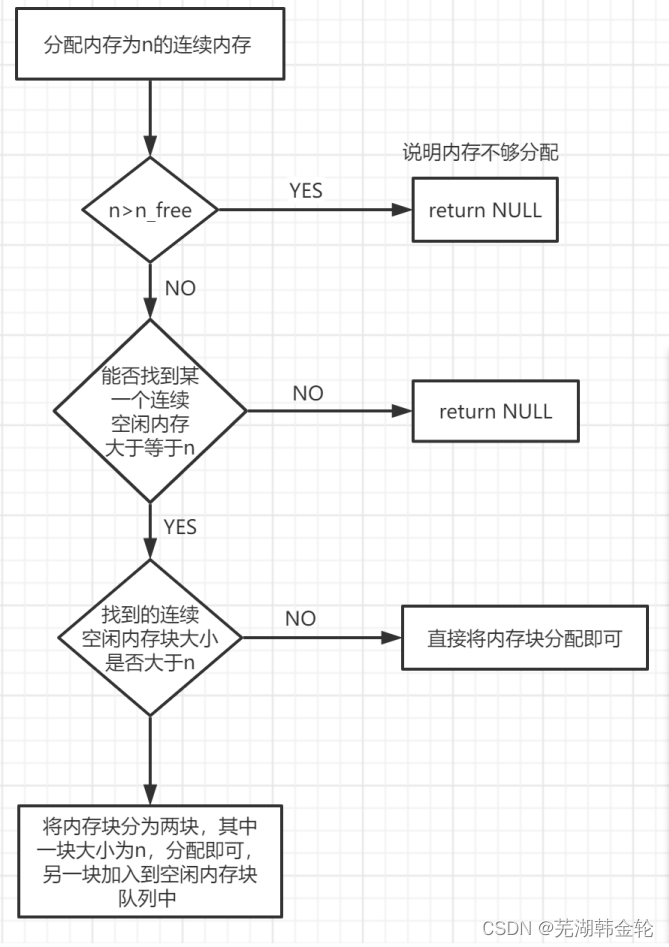
Free memory code , namely default_free_pages function
// release n Page blocks , After the release, we should also consider whether the released block is next to the existing free block , That is, those that can be merged
// If you can merge , Then merge , Otherwise, directly join the two-way linked list
static void default_free_pages(struct Page *base, size_t n)
{
assert(n > 0); //n Must be greater than 0
struct Page *p = base;
// First of all, will base-->base+n Between the memory tags as well ref initialization
for (; p != base + n; p ++)
{
assert(!PageReserved(p) && !PageProperty(p));
// take flags and ref Set to 0
p->flags = 0;
set_page_ref(p, 0);
}
// After the release, put this piece of property Change it to n
base->property = n;
SetPageProperty(base);
list_entry_t *le = list_next(&free_list);
// Check whether it can be merged into the appropriate page block
while (le != &free_list)
{
p = le2page(le, page_link);
le = list_next(le);
// If this block is in front of the next free block , The two can be combined
if (base + base->property == p)
{
// Give Way base Of property Equal to the sum of the sizes of the two blocks
base->property += p->property;
// Delete another free block
ClearPageProperty(p);
list_del(&(p->page_link));
}
// If this block is after the last free block , The two can be combined
else if (p + p->property == base)
{
// take p Of property Set to the sum of the two
p->property += base->property;
// Delete the following free blocks
ClearPageProperty(base);
base = p;
// Note that you need to p Delete , Because then confirm the insertion position again
list_del(&(p->page_link));
}
}
// The overall free space has increased n
nr_free += n;
le = list_next(&free_list);
// Add the merged appropriate page blocks back to the empty page block linked list
// Because you need to arrange the list in the order of memory from small to large , Therefore, it is necessary to find the position that should be inserted
while (le != &free_list)
{
p = le2page(le, page_link);
// Find the right place :
if (base + base->property <= p)
{
break;
}
// Otherwise, the linked list items are backward , Continue to find
le = list_next(le);
}
// take base Insert it into the correct position just found
list_add_before(le, &(base->page_link));
}
This function is used to add the released page back to the page list , The practice in this experiment is to traverse the linked list , Find the address of the first page that is greater than the address of the first page released , First, judge whether the base address of the released page plus the number of released pages is just equal to the found address , If yes, merge , Similarly, find the first one before this page property Not for 0 Page of , Judge whether the released page and the previous page are continuous , If continuous, merge .
The idea of freeing memory :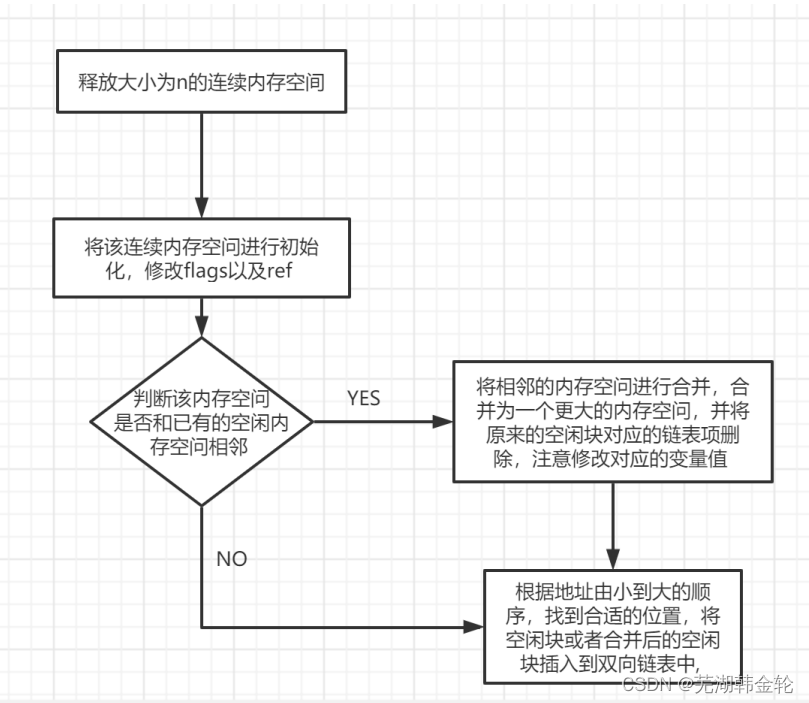
After completing the related functions , Conduct make qemu Instructions , You can see :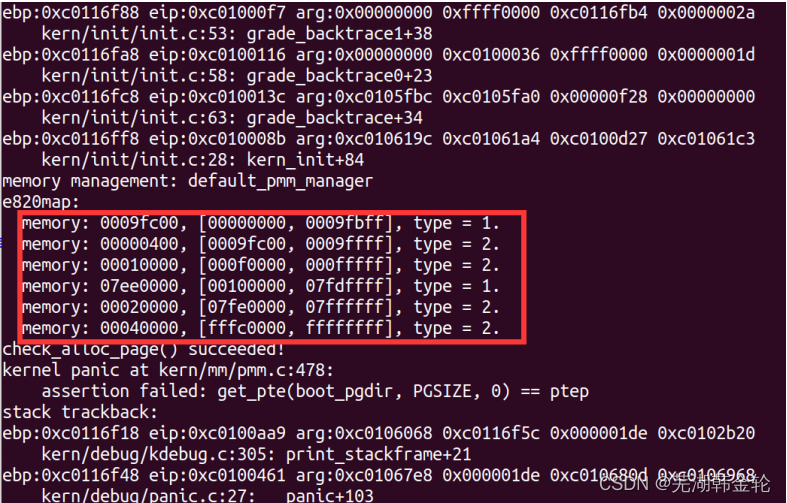
You can see , Memory allocated successfully , The algorithm passed the test .
Question answering
- Yours first fit Whether there is room for further improvement
First of all, we know that the complexity of the algorithm in allocating and releasing memory is O(n), Because you need to access the linked list , Therefore, the complexity is inevitably O(n);
We can use binary search tree to manage memory . Binary search tree is mainly used to sort addresses , Put into use free Time can be in O(logn) Complete the search of the location of the linked list items in time , So as to realize the optimization of time . As follows :
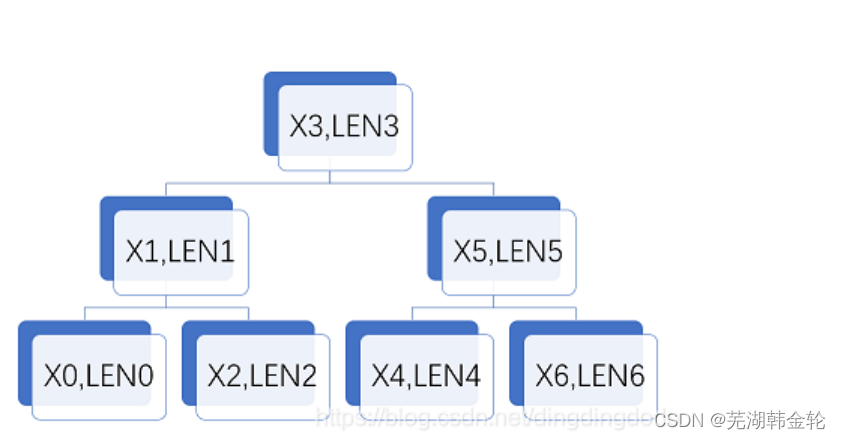
Sort by address , That is to ensure that the address value of the left node of any node of the binary tree is less than its own address value , The address value of the right node is greater than its own address value , Optimize by this method , We can do that O(n) The complexity of memory allocation , But it can. O(logn) The complexity of memory release , Because the process of judging the merger has been optimized . ad locum , We are right. LEN No requirements , But you have to make sure that X0<X1<X2<X3<X4<X5<X6, And there is no intersection and no adjacency between addresses . Through this method, the complexity of the algorithm is optimized .
practice 2: Find the page table item corresponding to the virtual address ( You need to program )
By setting the page table and the corresponding page table item , The corresponding relationship between virtual memory address and physical memory address can be established . Among them get_pte Function is an important step in setting page table items . This function finds the kernel virtual address of the secondary page table entry corresponding to a virtual address , If this secondary page entry does not exist , Then a secondary page table containing this item is allocated . This exercise needs to be completed get_pte function in kern/mm/pmm.c, Realize its function . Please check carefully and understand get_pte Comments in functions .get_pte The function call diagram is as follows :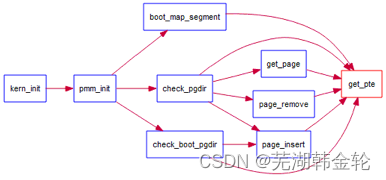
Please briefly describe your design and implementation process in the experimental report . Please answer the following questions :
- Please describe the page directory entry (Page Directory Entry) And page table entries (Page Table Entry) The meaning of each component of the and its impact on ucore The potential use of .
- If ucore Accessing memory during execution , Page access exception occurred , What does the hardware do ?
Prepare knowledge :
x86 The architecture divides memory addresses into three types : Logical address ( Also called virtual
Address )、 Linear address and Physical address .
- The logical address is the address used in the program instruction .
- The physical address is the address where the memory is actually accessed .
- Logical address can get linear address through the address mapping of segment management , Linear address through page Manage the address mapping to get the physical address .
get_pte The function gives the linear address , namely linear address. The relationship between the three is : Linear address (Linear Address) Is the middle layer between the logical address and the physical address transformation . The program code generates a logical address , Or the offset address in the segment , Add the base address of the corresponding segment to generate a linear address . If paging is enabled , Then the linear address can be transformed to produce a physical address .
The address conversion is shown in the figure :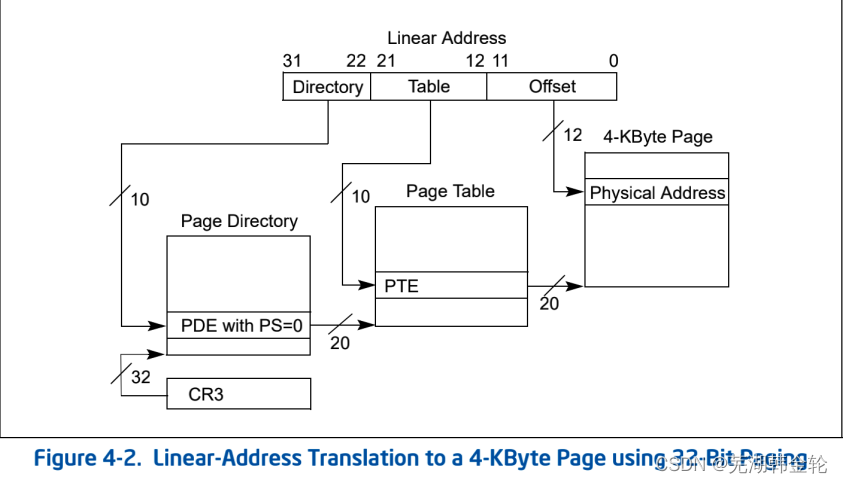
Ucore The page management of is realized through a two-level page table . The first level page table is stored in high 10 In a , The secondary page table is stored in the middle 10 In a , final 12 Bit represents offset , It can be proved that , Page size is 4KB(2 Of 12 Power ,4096).
- Directory It is a first level page table
- PDX(la) Can get Directory( Get the first level page table )
- Table It is a secondary page table
- PTX(la) Can get Table( Get the secondary page table )
get_pte Some macros and definitions are given in the comments of :
- PDX(la): Return the virtual address la Page directory index of
- KADDR(pa): Return the physical address pa Corresponding virtual address
- set_page_ref(page,1): Set this page to be referenced once
- page2pa(page): obtain page The physical address of the page managed
- struct Page * alloc_page() : Assign a page
- memset(void * s, char c, size_t n) : Set up s Point to the front of the address n Bytes to ‘c’
- PTE_P 0x001 Indicates that the physical memory page exists
- PTE_W 0x002 Indicates that the contents of the physical memory page are writable
- PTE_U 0x004 Indicates that the physical memory page content of the corresponding address can be read
The code is as follows :
// This function finds the kernel virtual address of the secondary page table entry corresponding to a virtual address , If this secondary page entry does not exist , Then a secondary page table containing this item is allocated
// pgdir:PDT Kernel virtual address la: Need mapped linear address creat: Decide whether to PT Assign the logical value of the page
//return vaule: This pte Kernel virtual address
pte_t *get_pte(pde_t *pgdir, uintptr_t la, bool create)
{
// Find the first level page table PDE
pde_t *pdep = pgdir + PDX(la);
// If it exists , Return the corresponding PTE that will do
if (*pdep & PTE_P) {
pte_t *ptep = (pte_t *)KADDR(*pdep & ~0x0fff) + PTX(la);
return ptep;
}
// If it doesn't exist, assign it page
struct Page *page;
if (!create || ((page = alloc_page()) == NULL))
{
return NULL;
}
// To find the table on this page , The number of citations +1
set_page_ref(page, 1);
// obtain page The linear address of
uintptr_t pa = page2pa(page) & ~0x0fff;
// Convert to virtual address and initialize to 0, Because the mapping has not yet started
memset((void *)KADDR(pa), 0, PGSIZE);
// Set control bit , Simultaneous setting PTE_U,PTE_W and PTE_P, The software representing the user status can read the physical memory page content of the corresponding address 、 The contents of the physical memory page can be written 、 Physical memory page exists .
*pdep = pa | PTE_P | PTE_W | PTE_U;
// return PTE
pte_t *ptep = (pte_t *)KADDR(pa) + PTX(la);
// Return the address of the corresponding page item
return ptep;
}
What to pay attention to :
adopt default_alloc_pages() The address of the assigned page is not the address of the real page , Actually, it's just Page The address of this structure , Therefore, it is necessary to use page2pa() take Page The address of this structure is converted into the linear address of the real physical page address , It should be noted that : Whether it's * or memset All of them operate on virtual addresses, so it is necessary to convert the real physical page address into the kernel virtual address .
Question answering :
- Please describe the page directory entry (Page Directory Entry) And page table entries (Page Table Entry) The meaning of each component of the and its impact on ucore The potential use of .
Page catalog entry (Page Directory Entry) Composition and pair ucore
The potential role of :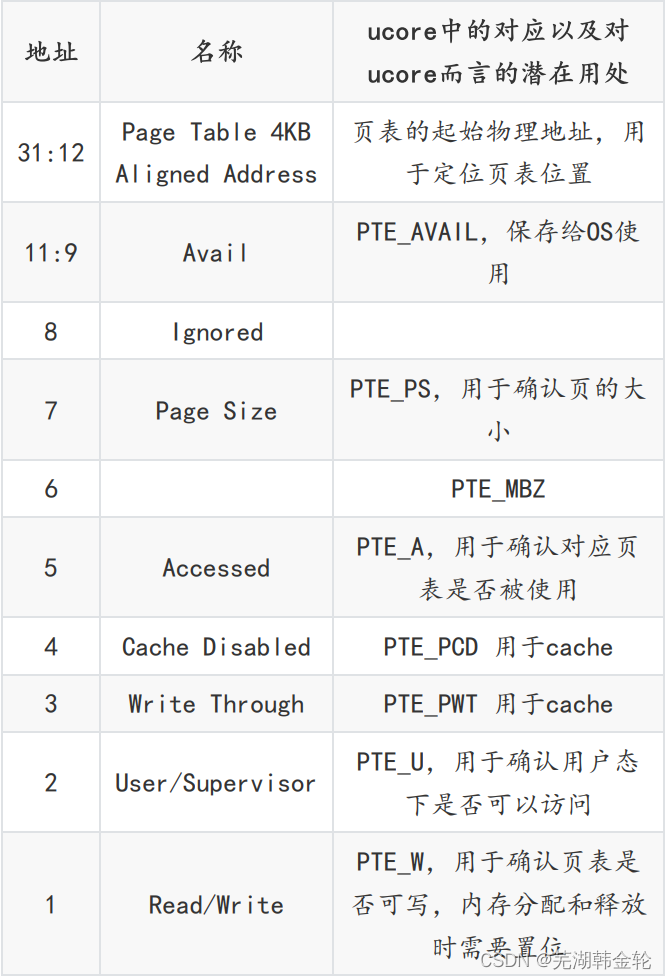

Page table item (Page Table Entry) The composition of ucore In terms of the
Potential effects :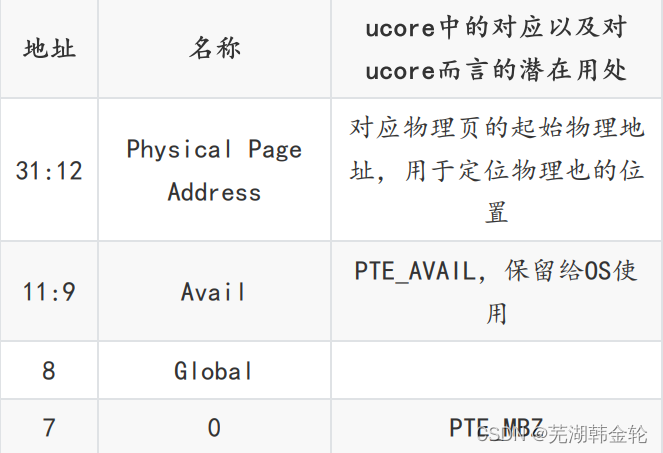
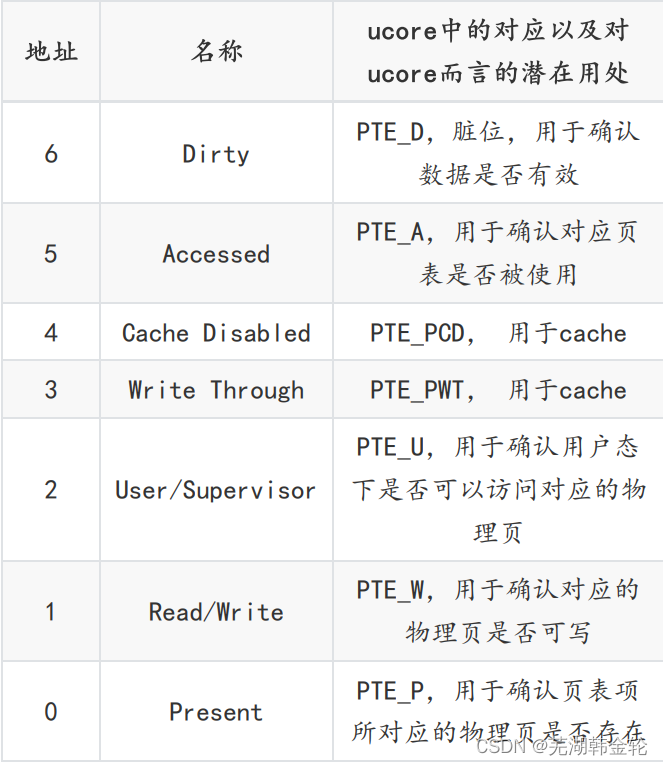
To make a long story short , Page directory entries are first level page tables , The starting address of each secondary page table is stored , Page table is a secondary page table , The starting address of each page is stored . A virtual address ( Linear address ) The final physical address is translated through the page mechanism .
The main function of page table is : If in the system , Physical memory and virtual memory are one-to-one correspondence , Then there will be many page tables in the process space , At the same time, it will occupy a lot of space , that , In order to solve this problem, multi-level page tables appear .
- If ucore Accessing memory during execution , Page access exception occurred , What does the hardware do ?
- The hardware is stuck in the kernel , Save program counters on the stack . Most machines store various status information of the current instruction in a special file CPU In the register .
- Start an assembly code routine to store general-purpose registers and other volatile information , To avoid being damaged by the operating system . This routine calls the operating system as a function .
- When the operating system finds a missing page interrupt , Try to find out which virtual page you need . Usually a hardware register contains this information , If not , The operating system must retrieve program counters , Take out this instruction , Analyze this instruction with software , See what it's doing when the page breaks .
- Once you know the virtual address where the missing page interrupt occurs , The operating system checks whether this address is valid , And check whether the access and protection are consistent . If it's not consistent , Send a signal to a process or kill it . If the address is valid and there is no protection, an error occurs , The system checks whether there is a free page box . If there is no free page box , Execute the page replacement algorithm to find a page to eliminate .
- If the selected page box “ dirty ” 了 , Schedule the page to be written back to disk , And a context switch occurs , Suspend the process that caused the missing page interrupt , Let other processes run until the disk transfer is over . in any case , The page box is marked as busy , To avoid being occupied by other processes for other reasons .
- Once the page box “ clean ” after ( Either immediately or after writing back to disk ), The operating system finds the address of the required page on disk , Mount it through disk operation . After the page is loaded , The process that caused the missing page interrupt is still suspended , And if there are other runnable user processes , Select another user process to run .
- When a disk interrupt occurs , Indicates that the page has been loaded , The page table has been updated to reflect its location , The page box is also marked as normal .
- Restore the state before the page break instruction occurs , The program counter points back to this instruction .
- Schedule the process that caused the missing page interrupt , The operating system returns the assembly language routine that calls it .
- This routine restores registers and other status information
practice 3: Release the page where a virtual address is located and unmap the corresponding secondary page table entry ( You need to program )
When a physical memory page containing a virtual address is released , You need to make the management data structure corresponding to this physical memory page Page Do relevant cleaning treatment , Make this physical memory page free ; In addition, the secondary page table entries representing the corresponding relationship between virtual address and physical address need to be cleared . Please check carefully and understand page_remove_pte Comments in functions . So , It needs to be completed in kern/mm/pmm.c Medium page_remove_pte function .page_remove_pte The function call diagram is as follows :
Please briefly describe your design and implementation process in the experimental report . Please answer the following questions :
- data structure Page Global variable of ( It's actually an array ) Whether each item of the page table corresponds to the page directory item and page table item in the page table ? If there is , What is the corresponding relationship ?
- If you want the virtual address to be equal to the physical address , How to modify lab2, Finish this ? Encourage programming to accomplish this problem
Ideas : Check whether the page table entry exists , If there is , Map its corresponding
The shooting relationship is cancelled , And will PTE eliminate , Then refresh tlb that will do .
static inline void
page_remove_pte(pde_t *pgdir, uintptr_t la, pte_t *ptep)
{
// Check page directory Whether there is
// Exercise 2 we have learned PTE_P Used to represent page dir Whether there is
if (*ptep & PTE_P)
{
struct Page *page = pte2page(*ptep);
// (page_ref_dec(page) take page Of ref reduce 1, And return to minus 1 After that ref
if (page_ref_dec(page) == 0) // If ref by 0, be free that will do
{
free_page(page);
}
// Clear the second page table PTE
*ptep = 0;
// Refresh tlb, Remove the secondary page table that clears the relationship , Update page directory entry
tlb_invalidate(pgdir, la);
}
}
After writing the code , It can be executed make qemu, Test exercise two and
Is the code of exercise 3 correct , The operation results are as follows :
[email protected]:~/os_kernel_lab/labcodes/lab2$ make qemu
+ cc kern/mm/pmm.c
kern/mm/pmm.c:266:1: warning: ‘boot_alloc_page’ defined but not
used [-Wunused-function]
boot_alloc_page(void) {
^~~~~~~~~~~~~~~
+ ld bin/kernel
+ ld bin/kernel_nopage
Recorded 10000+0 Read in of
Recorded 10000+0 Write
5120000 bytes (5.1 MB, 4.9 MiB) copied, 0.0208672 s, 245 MB/s
Recorded 1+0 Read in of
Recorded 1+0 Write
512 bytes copied, 0.000204289 s, 2.5 MB/s
Recorded 265+1 Read in of
Recorded 265+1 Write
135832 bytes (136 kB, 133 KiB) copied, 0.000493457 s, 275 MB/s
WARNING: Image format was not specified for 'bin/ucore.img' and
probing guessed raw.
Automatically detecting the format is dangerous for raw
images, write operations on block 0 will be restricted.
Specify the 'raw' format explicitly to remove the
restrictions.
(THU.CST) os is loading ...
Special kernel symbols:
entry 0xc0100036 (phys)
etext 0xc0106f2e (phys)
edata 0xc011d000 (phys)
end 0xc02a4960 (phys)
Kernel executable memory footprint: 1683KB
ebp:0xc0119f38 eip:0xc0100aa9 arg:0x00010094 0x00010094
0xc0119f68 0xc01000cd
kern/debug/kdebug.c:305: print_stackframe+21
ebp:0xc0119f48 eip:0xc0100d9f arg:0x00000000 0x00000000
0x00000000 0xc0119fb8
kern/debug/kmonitor.c:129: mon_backtrace+10
ebp:0xc0119f68 eip:0xc01000cd arg:0x00000000 0xc0119f90
0xffff0000 0xc0119f94
kern/init/init.c:48: grade_backtrace2+33
ebp:0xc0119f88 eip:0xc01000f7 arg:0x00000000 0xffff0000
0xc0119fb4 0x0000002b
kern/init/init.c:53: grade_backtrace1+38
ebp:0xc0119fa8 eip:0xc0100116 arg:0x00000000 0xc0100036
0xffff0000 0x0000001d
kern/init/init.c:58: grade_backtrace0+23
ebp:0xc0119fc8 eip:0xc010013c arg:0xc0106f5c 0xc0106f40
0x00187960 0x00000000
kern/init/init.c:63: grade_backtrace+34
ebp:0xc0119ff8 eip:0xc010008b arg:0xc010713c 0xc0107144
0xc0100d27 0xc0107163
kern/init/init.c:28: kern_init+84
memory management: default_pmm_manager
e820map:
memory: 0009fc00, [00000000, 0009fbff], type = 1.
memory: 00000400, [0009fc00, 0009ffff], type = 2.
memory: 00010000, [000f0000, 000fffff], type = 2.
memory: 07ee0000, [00100000, 07fdffff], type = 1.
memory: 00020000, [07fe0000, 07ffffff], type = 2.
memory: 00040000, [fffc0000, ffffffff], type = 2.
check_alloc_page() succeeded!
check_pgdir() succeeded!
check_boot_pgdir() succeeded!
-------------------- BEGIN --------------------
PDE(0e0) c0000000-f8000000 38000000 urw
|-- PTE(38000) c0000000-f8000000 38000000 -rw
PDE(001) fac00000-fb000000 00400000 -rw
|-- PTE(000e0) faf00000-fafe0000 000e0000 urw
|-- PTE(00001) fafeb000-fafec000 00001000 -rw
--------------------- END ---------------------
++ setup timer interrupts
0: @ring 0
0: cs = 8
0: ds = 10
0: es = 10
0: ss = 10
+++ switch to user mode +++
100 ticks
100 ticks
100 ticks
By running the results , We can see ucore Show its entry( Entrance address )、etext( The address of the end of the code segment )、edata( Address of the end of the data segment )、 and end(ucore End address ) After the value of , Detect the layout of physical memory in the computer system (e820map What is displayed under ). Next ucore It can realize a simple memory allocation management with pages as the minimum allocation unit , Complete the establishment of the secondary page table , Enter paging mode , Perform various checks we set up , Finally, it shows ucore The content of the established secondary page table , And respond to clock interrupt in paging mode .
Running at the same time make grade Check the scores 
Explain the exercise 2 And practice 3 The codes of are correct .
Question answering
- data structure Page Global variable of ( It's actually an array ) Whether each item of the page table corresponds to the page directory item and page table item in the page table ? If there is , What is the corresponding relationship ?
pages Each item of the page table corresponds to the page directory item and page table item in the page table ,pages Each item corresponds to the information of a physical page . A page directory item corresponds to a page table , A page table item corresponds to a physical page . Suppose there is N Physics pages ,pages The length of is N, And page directory entries 、 Front of page table item 20 Bit corresponds to the physical page number .
As shown in the figure below :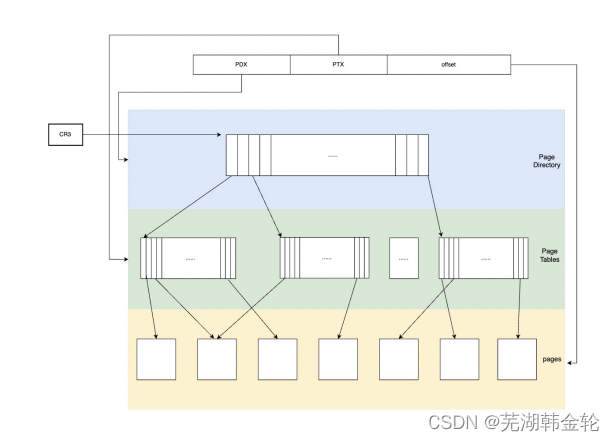
One PDE Corresponding 1024 individual PTE, One PTE Corresponding 1024 individual page.
- If you want the virtual address to be equal to the physical address , How to modify
lab2, Finish this ? Encourage programming to accomplish this problem
Between physical address and virtual address offset:
phy addr + KERNBASE = virtual addr
therefore ,KERNBASE = 0 when ,phy addr = virtual addr
So the memlayout.h Medium
/* All physical memory mapped at this address */
#define KERNBASE 0x00000000
take KERNBASE Change it to 0 that will do .
Extended exercises Challenge:buddy system( Buddy system ) Allocation algorithm ( You need to program )
Buddy System The algorithm divides the available storage space into storage blocks (Block) To manage , The size of each storage block must be 2 Of n The next power (Pow(2, n)), namely 1, 2, 4, 8, 16, 32, 64, 128…
- A minimalist implementation of the reference partner allocator , stay ucore To realize buddy system Allocation algorithm , Sufficient test cases are required to illustrate the correctness of the implementation , Design documentation is required .
Prepare knowledge
buddy system: The essence of partner distribution is a special “ Separation and adaptation ”, About to press memory 2 Divided by the power of , It is equivalent to separating several free linked lists with the same block size , Search the linked list and give the size of the best match with the demand .
The algorithm is basically :
Allocate memory :
- Looking for the right size memory block ( Greater than or equal to the required size and closest to 2 The power of , Such as the need to 27, Actual distribution 32):
- If you find it , Assigned to the application
- If not , Separate out the appropriate memory block
- Separate the free memory blocks larger than the required size in half
- If it gets to the minimum , Allocate this size .
- Back to the steps 1( Looking for blocks of the right size )
- Repeat this step until a suitable block
Free memory :
- Release the memory block
- Look for adjacent blocks , See if it's released .
- If adjacent blocks are also released , Merge these two blocks , Repeat the above steps until Encounter an unreleased adjacent block , Or reach the maximum limit ( That is, all memory It's all released ).
The whole idea of distributor :
Monitor and manage memory through a complete binary tree in the form of an array , The node of the binary tree is used to mark the usage status of the corresponding memory block , High level nodes correspond to large blocks , Low level nodes correspond to small blocks , In the allocation and release, we separate and merge blocks through the tag attributes of these nodes . As shown in the figure , Suppose the total size is 16 Unit of memory , We will establish a depth of 5 Full binary tree , The root node subscripts from the array [0] Start , Monitor size 16 The block ; Its left and right child nodes are subscripts [1~ 2], Monitor size 8 The block ; The subscript of the third layer node [3~6] Monitor size 4 The block …… And so on .
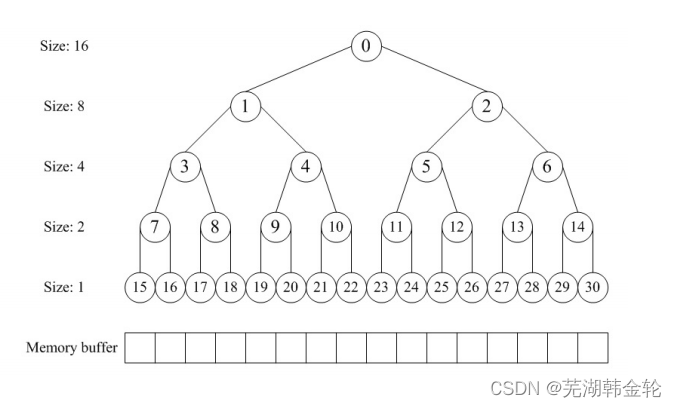
Realization buddy system Allocation algorithm
First analysis ucore Implementation process of :
From practice 1 In the clear , The memory allocation function is in default_pmm.c in
Realized , And in pmm.c Call in , therefore imitation default_pmm.h and pmm.c The creation is complete buddy.h and buddy.c.
buddy.h The implementation of the :
#ifndef __KERN_MM_BUDDY_PMM_H__
#define __KERN_MM_BUDDY_PMM_H__
#include <pmm.h>
extern const struct pmm_manager buddy_pmm_manager;
#endif /* ! __KERN_MM_DEFAULT_PMM_H__ */
take pmm.c Medium init_pmm_manager Function pmm_manager
Value is modified to buddy_pmm_manager , namely :
static void
init_pmm_manager(void) {
pmm_manager = &buddy_pmm_manager;
cprintf("memory management: %s\n", pmm_manager->name);
pmm_manager->init();
}
Simultaneous completion buddy.c Code :
#include <pmm.h>
#include <list.h>
#include <string.h>
#include <default_pmm.h>
#include <buddy.h>
// Some macro definitions from resources
#define LEFT_LEAF(index) ((index) * 2 + 1)// The value of the left subtree node
#define RIGHT_LEAF(index) ((index) * 2 + 2)// The value of the right subtree node
#define PARENT(index) ( ((index) + 1) / 2 - 1)// The value of the parent node
#define IS_POWER_OF_2(x) (!((x)&((x)-1)))//x Is it right? 2 The power of
#define MAX(a, b) ((a) > (b) ? (a) : (b))// Judge a,b size
#define UINT32_SHR_OR(a,n) ((a)|((a)>>(n)))// Move right n position
#define UINT32_MASK(a)
(UINT32_SHR_OR(UINT32_SHR_OR(UINT32_SHR_OR(UINT32_SHR_OR(UINT32_
SHR_OR(a,1),2),4),8),16))
// Greater than a The smallest of 2^k
#define UINT32_REMAINDER(a) ((a)&(UINT32_MASK(a)>>1))
#define UINT32_ROUND_DOWN(a) (UINT32_REMAINDER(a)?((a)-
UINT32_REMAINDER(a)):(a))// Less than a One of the biggest 2^k
static unsigned fixsize(unsigned size) {
// Find a memory greater than or equal to the required 2
Multiple
size |= size >> 1;
size |= size >> 2;
size |= size >> 4;
size |= size >> 8;
size |= size >> 16;
return size+1;
}
struct buddy2 {
unsigned size;// Indicates the total number of units of managed memory
unsigned longest; // Node marking of binary tree , Indicates the free unit of the corresponding memory block
};
struct buddy2 root[80000];// An array of binary trees , For memory allocation
free_area_t free_area;
#define free_list (free_area.free_list)
#define nr_free (free_area.nr_free)
struct allocRecord// Record the information of the allocation block
{
struct Page* base;
int offset;
size_t nr;// Block size
};
struct allocRecord rec[80000];// An array of offsets
int nr_block;// Number of allocated blocks
static void buddy_init()
{
list_init(&free_list);
nr_free=0;
}
// Initialize the node on the binary tree
void buddy2_new( int size ) {
unsigned node_size;
int i;
nr_block=0;
if (size < 1 || !IS_POWER_OF_2(size))
return;
root[0].size = size;
node_size = size * 2;
for (i = 0; i < 2 * size - 1; ++i) {
if (IS_POWER_OF_2(i+1))
node_size /= 2;
root[i].longest = node_size;
}
return;
}
// Initialize the memory mapping relationship
static void
buddy_init_memmap(struct Page *base, size_t n)
{
assert(n>0);
struct Page* p=base;
for(;p!=base + n;p++)
{
assert(PageReserved(p));
p->flags = 0;
p->property = 1;
set_page_ref(p, 0);
SetPageProperty(p);
list_add_before(&free_list,&(p->page_link));
}
nr_free += n;
int allocpages=UINT32_ROUND_DOWN(n);
buddy2_new(allocpages);
}
// Memory allocation
int buddy2_alloc(struct buddy2* self, int size) {
unsigned index = 0;// Node label ( The array subscript )
unsigned node_size;
unsigned offset = 0;// Offset
if (self==NULL)// Can't assign
return -1;
if (size <= 0)// The distribution is unreasonable
size = 1;
else if (!IS_POWER_OF_2(size))// Not for 2 Power time , Take ratio size Bigger 2 Of n
The next power
size = fixsize(size);
if (self[index].longest < size)// Insufficient allocable memory
return -1;
for(node_size = self->size; node_size != size; node_size /= 2
) {
// Start from the largest root node and look down for the appropriate node
// The left subtree takes precedence
if (self[LEFT_LEAF(index)].longest >= size)
{
if(self[RIGHT_LEAF(index)].longest>=size)
{
index=self[LEFT_LEAF(index)].longest <=
self[RIGHT_LEAF(index)].longest?
LEFT_LEAF(index):RIGHT_LEAF(index);
// Find the node with smaller memory in the two matching nodes
}
else
{
index=LEFT_LEAF(index);
}
}
else
index = RIGHT_LEAF(index);
}
self[index].longest = 0;// Mark node as used
offset = (index + 1) * node_size - self->size;// Calculate the offset
// Refresh up
while (index) {
index = PARENT(index);
self[index].longest =
MAX(self[LEFT_LEAF(index)].longest,
self[RIGHT_LEAF(index)].longest);
// Refresh parent node
}
return offset;
}
static struct Page*
buddy_alloc_pages(size_t n){
assert(n>0);
if(n>nr_free)
return NULL;
struct Page* page=NULL;
struct Page* p;
list_entry_t *le=&free_list,*len;
rec[nr_block].offset=buddy2_alloc(root,n);// Record the offset
int i;
for(i=0;i<rec[nr_block].offset+1;i++)
le=list_next(le);
page=le2page(le,page_link);
int allocpages;
if(!IS_POWER_OF_2(n))
allocpages=fixsize(n);
else
{
allocpages=n;
}
// According to the demand n Get the block size
rec[nr_block].base=page;// Record allocation block
rec[nr_block].nr=allocpages;// Record the number of pages allocated
nr_block++;
for(i=0;i<allocpages;i++)
{
len=list_next(le);
p=le2page(le,page_link);
ClearPageProperty(p);
le=len;
}// Change the status of each page
nr_free-=allocpages;// Minus the number of pages allocated
page->property=n;
return page;
}
void buddy_free_pages(struct Page* base, size_t n) {
unsigned node_size, index = 0;
unsigned left_longest, right_longest;
struct buddy2* self=root;
list_entry_t *le=list_next(&free_list);
int i=0;
for(i=0;i<nr_block;i++)// Find a block
{
if(rec[i].base==base)
break;
}
int offset=rec[i].offset;
int pos=i;// The staging i
i=0;
while(i<offset)
{
le=list_next(le);
i++;
}
int allocpages;
if(!IS_POWER_OF_2(n))
allocpages=fixsize(n);
else
{
allocpages=n;
}
assert(self && offset >= 0 && offset < self->size);// Is it legal
node_size = 1;
index = offset + self->size - 1;
nr_free+=allocpages;// Update the number of free pages
struct Page* p;
self[index].longest = allocpages;
for(i=0;i<allocpages;i++)// Recycle allocated pages
{
p=le2page(le,page_link);
p->flags=0;
p->property=1;
SetPageProperty(p);
le=list_next(le);
}
while (index) {
// Merge up , Modify the record value of the ancestor node
index = PARENT(index);
node_size *= 2;
left_longest = self[LEFT_LEAF(index)].longest;
right_longest = self[RIGHT_LEAF(index)].longest;
if (left_longest + right_longest == node_size)
self[index].longest = node_size;
else
self[index].longest = MAX(left_longest, right_longest);
}
for(i=pos;i<nr_block-1;i++)// Clear the allocation record this time
{
rec[i]=rec[i+1];
}
nr_block--;// Update the value of the number of allocated blocks
}
static size_t
buddy_nr_free_pages(void) {
return nr_free;
}
// Here is a test function
static void
buddy_check(void) {
struct Page *p0, *A, *B,*C,*D;
p0 = A = B = C = D =NULL;
assert((p0 = alloc_page()) != NULL);
assert((A = alloc_page()) != NULL);
assert((B = alloc_page()) != NULL);
assert(p0 != A && p0 != B && A != B);
assert(page_ref(p0) == 0 && page_ref(A) == 0 && page_ref(B)
== 0);
free_page(p0);
free_page(A);
free_page(B);
A=alloc_pages(500);
B=alloc_pages(500);
cprintf("A %p\n",A);
cprintf("B %p\n",B);
free_pages(A,250);
free_pages(B,500);
free_pages(A+250,250);
p0=alloc_pages(1024);
cprintf("p0 %p\n",p0);
assert(p0 == A);
// The following is written based on the sample test in the link
A=alloc_pages(70);
B=alloc_pages(35);
assert(A+128==B);// Check whether it is adjacent
cprintf("A %p\n",A);
cprintf("B %p\n",B);
C=alloc_pages(80);
assert(A+256==C);// Check C Is there any and A overlap
cprintf("C %p\n",C);
free_pages(A,70);// Release A
cprintf("B %p\n",B);
D=alloc_pages(60);
cprintf("D %p\n",D);
assert(B+64==D);// Check B,D Is it adjacent
free_pages(B,35);
cprintf("D %p\n",D);
free_pages(D,60);
cprintf("C %p\n",C);
free_pages(C,80);
free_pages(p0,1000);// Release all
}
const struct pmm_manager buddy_pmm_manager = {
.name = "buddy_pmm_manager",
.init = buddy_init,
.init_memmap = buddy_init_memmap,
.alloc_pages = buddy_alloc_pages,
.free_pages = buddy_free_pages,
.nr_free_pages = buddy_nr_free_pages,
.check = buddy_check,
};
function make qemu, have to 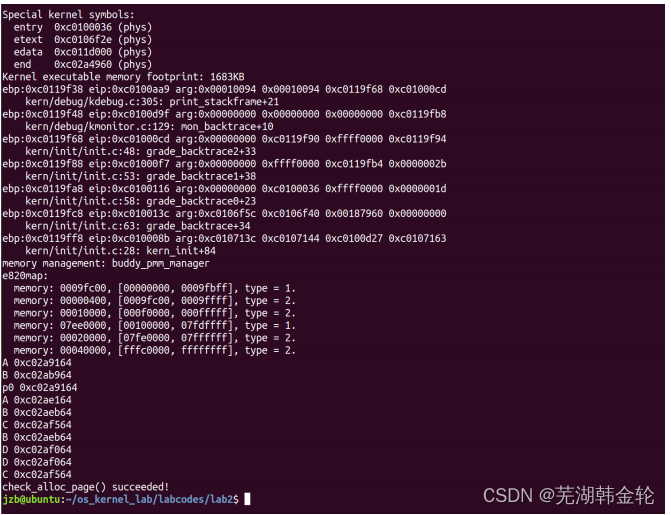
Running normally , And it has been tested to be correct , Can achieve challenge What we need
seek .
Extended exercises Challenge: Memory units of any size slub Allocation algorithm ( You need to program )
slub Algorithm , Realize efficient memory unit allocation of two-tier architecture , The first layer is memory allocation based on page size , The second layer is to realize memory allocation based on arbitrary size on the basis of the first layer . Can simplify the implementation of , Can reflect its main idea .
- Reference resources linux Of slub Allocation algorithm /, stay ucore To realize slub Allocation algorithm . Sufficient test cases are required to illustrate the correctness of the implementation , Design documentation is required .
Summary of the experiment
The previous exercise 1~3 Let me have a deep understanding of the memory management and other mechanisms of the operating system , For example, different memory allocation algorithms and page tables .
challenge I think it is more challenging , But with practice 1 There is a certain connection , All are to complete the allocation and release of memory . Read the reference link of partner algorithm given in the guide , The author of this article seems to like this algorithm very much , But this algorithm still has some shortcomings , Compared with the practice First-Fit, Instead, its internal fragments have become larger , And it wastes a lot , Such as the need to 9K, Must allocate 16K Space leads to 7K Be wasted . The merger requirements are too strict , Only blocks that meet the partnership can be merged . The advantage is that it can better solve the problem of external fragments , Moreover, it is mentioned in the query of relevant information that the partner algorithm is designed for large memory allocation .
in general ,lab2 The harvest is still great , And as the experimental guide said at the beginning ,lab1 and lab2 More difficult , But through lab1 and lab2 after , Interruption in computer theory 、 Segment page table mechanism 、 The understanding of privilege level will be deeper . It is of great help to the later study .
边栏推荐
- The four connection methods of JDBC are directly coded
- 150 common interview questions for software testing in large factories. Serious thinking is very valuable for your interview
- Public key box
- 指针:最大值、最小值和平均值
- Face and eye recognition based on OpenCV's own model
- The common methods of servlet context, session and request objects and the scope of storing data in servlet.
- 使用 flask_whooshalchemyplus jieba实现flask的全局搜索
- How to learn automated testing in 2022? This article tells you
- Rearrange spaces between words in leetcode simple questions
- [pointer] octal to decimal
猜你喜欢

Maximum nesting depth of parentheses in leetcode simple questions

The minimum sum of the last four digits of the split digit of leetcode simple problem

Réponses aux devoirs du csapp 7 8 9

Don't you even look at such a detailed and comprehensive written software test question?

How to learn automated testing in 2022? This article tells you

How to transform functional testing into automated testing?

Dlib detects blink times based on video stream
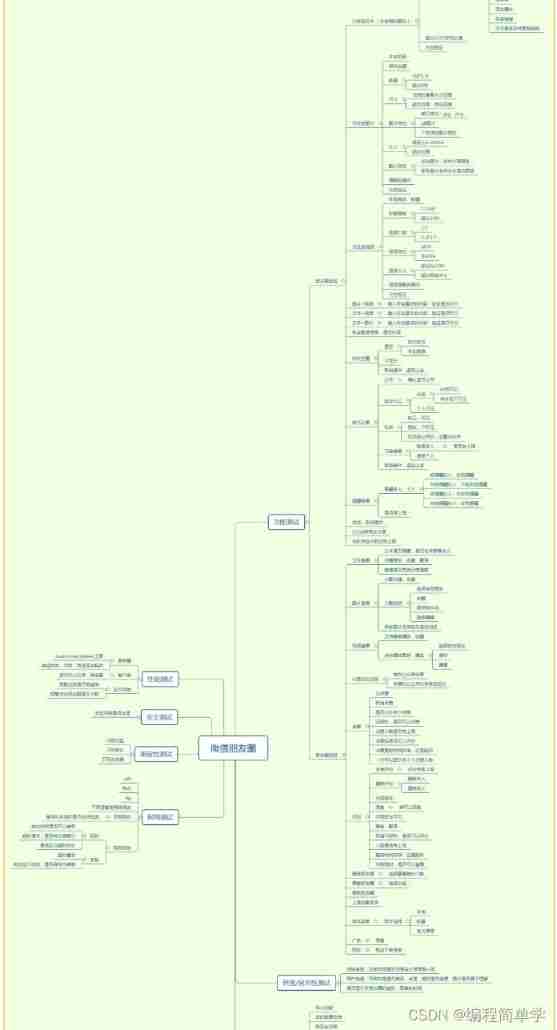
Software testing interview summary - common interview questions

ucore lab2 物理内存管理 实验报告

“Hello IC World”
随机推荐
The common methods of servlet context, session and request objects and the scope of storing data in servlet.
Zhejiang University Edition "C language programming experiment and exercise guide (3rd Edition)" topic set
[HCIA continuous update] working principle of static route and default route
Vysor uses WiFi wireless connection for screen projection_ Operate the mobile phone on the computer_ Wireless debugging -- uniapp native development 008
Functions: Finding Roots of equations
ByteDance ten years of experience, old bird, took more than half a year to sort out the software test interview questions
刷视频的功夫,不如看看这些面试题你掌握了没有,慢慢积累月入过万不是梦。
1.支付系统
王爽汇编语言学习详细笔记一:基础知识
Expanded polystyrene (EPS) global and Chinese markets 2022-2028: technology, participants, trends, market size and share Research Report
ucore lab2 物理内存管理 实验报告
Opencv recognition of face in image
函数:求1-1/2+1/3-1/4+1/5-1/6+1/7-…+1/n
Function: find the maximum common divisor and the minimum common multiple of two positive numbers
[pointer] use the insertion sorting method to arrange n numbers from small to large
Numpy Quick Start Guide
China's county life record: go upstairs to the Internet, go downstairs' code the Great Wall '
Differences between select, poll and epoll in i/o multiplexing
Global and Chinese market of goat milk powder 2022-2028: Research Report on technology, participants, trends, market size and share
[pointer] find the largest string